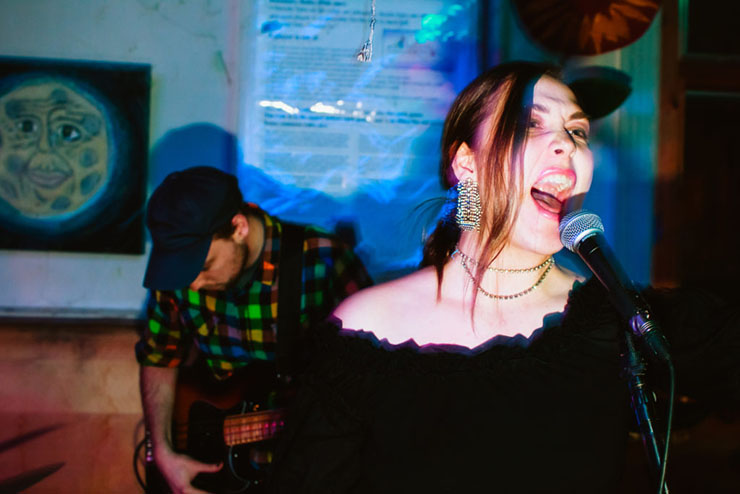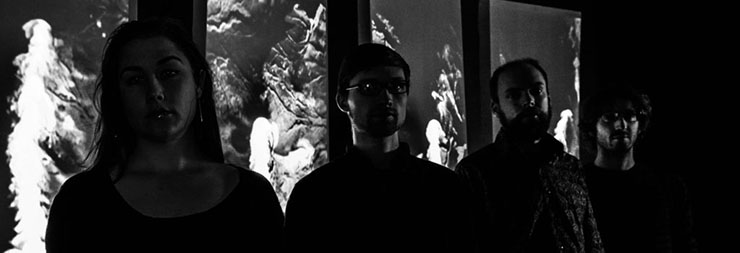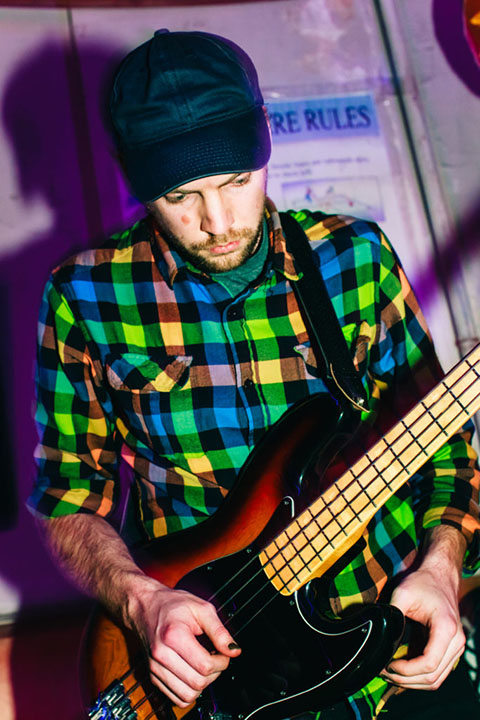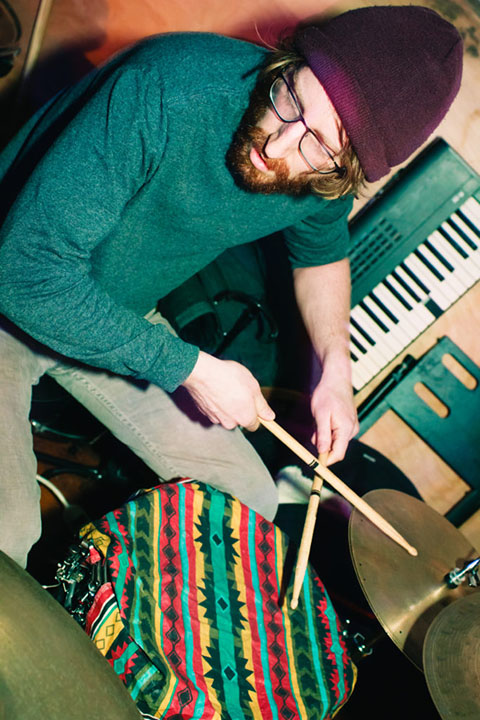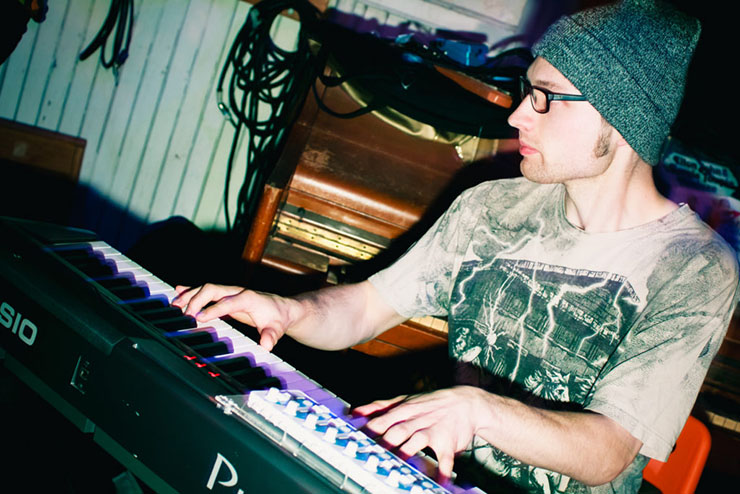A mark of any good live band is the ability to improvise. Not only does it showcase polished musicianship, but it gives even the most enthusiastic fans something new and exciting. Within this “jam” section, the foundation of a band is put to the test: trust, teamwork, creativity, and collaboration. There are many Detroit acts who can concoct a great improvised live jam, but it is rare to see musicians thrive in this sonic space as saajtak do.
The group comprise four members, each of whom can be described as an inventive composer and vehement performer. With their combined forces, saajtak are nothing if not unpredictable, bobbing between feverish noise and lush, operatic soundscapes with the agility of a hummingbird. Needless to say, we were intrigued, so we connected with the band to try and make sense of it all.
Walk me through the origin story of saajtak. What brought you together as a band?
Simon Alexander-Adams: We met each other in the Creative Arts Orchestra, which is a large all-improvising ensemble at the University of Michigan. That group is great because it offers a platform for developing musical dialogue, often between musicians of completely different backgrounds. It forges strong relationships, and so inevitably, you get a lot of independent collaborations. Alex, Jon, and I started playing together as an extension of that setting, just meeting in Jon’s basement, recording on a cellphone.
Jon Taylor: And we met without any particular agenda, really. I don’t think we necessarily expected a long-term project, but in all of those early sessions, the ideas were so strong and the connection was so deep that we all felt inspired to keep pushing forward. Eventually we realized we had a band on our hands and wanted to expand our sound palette. Ben, who I had played with in some half dozen projects over the previous two years and is one of my favorite musicians around, was an obvious choice to fill out the group.
What was the process like while creating this new EP? Was there any particular source of inspiration?
SAA: We had been working on the content for [the] Spokes EP over the last two years or so, and it continued changing and developing through the recording process. With some of these songs, we were making changes the day of the recording session.
Ben Willis: To preserve the live performance aspect of the songs, most of the EP was tracked live. The drums, bass, and keyboard were all played together in a single take, and then Alex was able to further orchestrate and layer her sounds on top of a more organic structure that we achieved through playing live in the studio.
Alex Koi: Yep. While in the studio, I was singing along with the guys — scratch vocals. After we had a decent board mix of the session, it took me a good three months to record all the voice parts because vibing with a recording is very different than vibing with a live sound. The time for vocal overdubs is one of my favorites, because it’s my opportunity to contribute my full artistry to the group in ways that are impossible to do in a live set. On these recordings, I can be ten different voices or act like a choir with part doubling and such. I’m very into large, lush sounds so the Spokes EP has some pretty heavy vocal orchestration.
The band’s overall sound is very experimental, but are there some specific genres or types of music that you each like to lean into?
BW: Personally, I think a lot of my musical thinking comes from playing a string instrument and developing a textural approach through playing and listening to chamber music written in the last half century. Like Kaija Saariaho and Helmut Lachenmann’s explorations of really detailed and distinct string effects and pieces like Luciano Berio’s Sinfonia that layer crazy voices on top of each other to create dense and immersive cityscapes. We also have an intuitive, ritualistic approach to playing, informed by musicians like Meredith Monk, Philip Glass, and David Torn — these performers who create a whole world within the performance of their music.
SAA: I love finding a unique sound world for each song. While the music of artists like Aphex Twin, Prefuse 73, or Amon Tobin have sonic threads that pull them together, there is often significant variety in the sounds used track to track. Aphex Twin might use all prepared piano samples and pivot to nothing but drum machines and acid synths going crazy. These tracks fit cohesively in one album, not due to the homogeneity of their sound, but from the consistency in compositional ideas and style. I often apply that approach with saajtak.
JT: When saajtak [were] first coming together, I was investigating Steve Coleman’s music, which involves polyrhythmic concepts of time cycles stacked on top of each other. It’s complex music, but it boils down to the very visceral experience of feeling many pulses in real time. A lot of our music involves so called “odd-meters,” but we’re not concerned with the numbers themselves, more with the flow and sound inherent in diverse rhythms.
AK: Definitely. Multiple people at our shows, both musicians and non-musicians, have shared having an experience like that with our music. They say, “I couldn’t tell you where the pulse was, but my body wanted to move the whole time.” That people feel a natural instinct to dance at our shows is a sign of success for me. Honestly, I wish more people did. It’s the kind of music that begs for fully open, both hands in the air, skip-around, interpretive-style movement.
What can people expect from a saajtak live performance? Do you all stick to performing recorded material, or is the audience more likely to hear an improvised jam?
BW: We’re always exploring different avenues and opportunities within the music. Every time we perform, we’re looking for new ways to interact with each other and new ways to weave the set together with spontaneous interludes. Sometimes we make plans, and sometimes we have no plans, so that keeps us on our toes.
JT: We’ve improvised so much together as a group and within so many different performance contexts that we trust each other to make decisions on the spot. That’s part of the fun of the group, the excitement, and why we’re so committed to it — we can always find something new.
AK: Right. There is a lot of trust and respect in this group. That’s certainly not to say though that the shows don’t keep us on our feet. We’re especially open-ended about endings. Frequently, one of us will trickle into an alternate ending or even initiate a new, unexpected direction. The rest of us pick up on it immediately and either choose silence or sound to accompany that direction. When we first started performing as saajtak, I was uncertain about where to position myself on stage because our roles are so fluid. I don’t always play into the “singer in front” mentality, and I don’t love being called “the singer” of this group. I’m an instrument, a texture, or a bass line. Most of the time, I have no option but to stand in front of the guys because of the size of the stage or the monitor situation, but ideally I like to be able to move around. Sometimes I stand with them in a row so that it creates a more contemporary classical ensemble vibe. Down the road it would be sweet to sing from a box in the audience or behind the drums or in another room. Something that forces the audience’s eyes to see them first. You know, play with the conventions of roles in a band.
SAA: We don’t play the compositions the same way we recorded them. Maybe they’ll be smashed up together or transition into one another seamlessly, or they’ll emerge from some noisy, ambient depths. Our songs function as scaffolding that we can build a recording around, or as structures for improvisation to be augmented or changed in performance.
What can we expect next from the band?
AK: New songs! Opening for Miley Cyrus!
BW: Yeah, we’re working on a conceptual dubstep throwback record right now…
SAA: [Laughing] But in all seriousness, we do have a couple of performances coming up. We’re opening for Xiu Xiu at El Club on Thursday, March 30.
JT: We’re performing in a new warehouse space on Fenkell on May 20, presented by the Detroit Bureau of Sound. We’re playing with this touring percussion and electronics project called Pillars of Decay. They’ve built a collection of instruments from found objects and scrap metal, and [they] perform pieces on these instruments written for them by an array of different composers.
AK: We’re also planning on having an official EP release party this spring or summer, plus a fall tour. Stay tuned for all that and a bunch of new announcements on our website.
You can find out more about saajtak from the band’s website, and you can listen to their new EP, Spokes, at their Bandcamp page.
First photo by Costa Kazaleh-Sirdenis. All other photos by Miles Larson.
